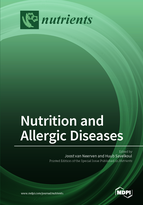Nutrition and Allergic Diseases
A special issue of Nutrients (ISSN 2072-6643).
Deadline for manuscript submissions: closed (31 May 2017) | Viewed by 190122
Special Issue Editors
Interests: mucosal immunology; allergy; asthma; food allergy; nutrition; dairy
Special Issues, Collections and Topics in MDPI journals
Interests: the regulation of IgE antibody formation in allergy, the immunogenicity and allergenicity of dietary components, the basic immune-mediated mechanisms in food allergy, the immunomodulation by food and feed, and the development of allergy-linked immunodiagnostics
Special Issues, Collections and Topics in MDPI journals
Special Issue Information
Dear Colleagues,
The purpose of this Special Issue, “Nutrition and Allergic Diseases”, is to provide an overview of the role of nutrition in allergy. The prevalence of asthma, rhinitis and food allergy has increased tremendously over the last few decades. Is there a role for nutrition to help managing this global challenge? This Special Issue will touch upon the many aspects that relate to nutrition and allergy, and focuses on two fundamental questions:
1) Can nutrition play a role in allergy prevention and induction?
2) Can nutrition play a role in managing allergies?
The topics covered should range from epidemiology of nutrition and allergy prevalence, through breastfeeding, microbiota, food allergy, immunotherapy approaches for food allergy, early introduction of food components, food processing, and known effects of food components on allergy.
Professor Joost van Neerven
Professor Huub Savelkoul
Guest Editors
Manuscript Submission Information
Manuscripts should be submitted online at www.mdpi.com by registering and logging in to this website. Once you are registered, click here to go to the submission form. Manuscripts can be submitted until the deadline. All submissions that pass pre-check are peer-reviewed. Accepted papers will be published continuously in the journal (as soon as accepted) and will be listed together on the special issue website. Research articles, review articles as well as short communications are invited. For planned papers, a title and short abstract (about 100 words) can be sent to the Editorial Office for announcement on this website.
Submitted manuscripts should not have been published previously, nor be under consideration for publication elsewhere (except conference proceedings papers). All manuscripts are thoroughly refereed through a single-blind peer-review process. A guide for authors and other relevant information for submission of manuscripts is available on the Instructions for Authors page. Nutrients is an international peer-reviewed open access semimonthly journal published by MDPI.
Please visit the Instructions for Authors page before submitting a manuscript. The Article Processing Charge (APC) for publication in this open access journal is 2900 CHF (Swiss Francs). Submitted papers should be well formatted and use good English. Authors may use MDPI's English editing service prior to publication or during author revisions.
Keywords
- Asthma
- Breastfeeding
- Epidemiology (nutrition and allergy)
- (Food) allergy
- Early food introduction and allergy
- Food processing
- Hydrolysates
- Immunotherapy (food allergy)
- Maternal diet
- Microbiota and allergy
- Nutrition
- Oligosaccharides
- Prebiotics
- Probiotics
- Rhinitis
- Short chain fatty acids (SCFA)
- Tolerance
- Poly unsaturated fatty acids (PUFA)








